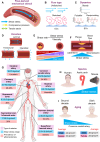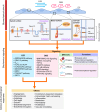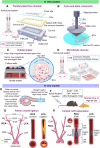Biophysical and Biochemical Roles of Shear Stress on Endothelium: A Revisit and New Insights
- PMID: 40146803
- PMCID: PMC11949231
- DOI: 10.1161/CIRCRESAHA.124.325685
Biophysical and Biochemical Roles of Shear Stress on Endothelium: A Revisit and New Insights
Abstract
Hemodynamic shear stress, the frictional force exerted by blood flow on the endothelium, mediates vascular homeostasis. This review examines the biophysical nature and biochemical effects of shear stress on endothelial cells, with a particular focus on its impact on cardiovascular pathophysiology. Atherosclerosis develops preferentially at arterial branches and curvatures, where disturbed flow patterns are most prevalent. The review also highlights the range of shear stress across diverse human arteries and its temporal variations, including aging-related alterations. This review presents a summary of the critical mechanosensors and flow-sensitive effectors that respond to shear stress, along with the downstream cellular events that they regulate. The review evaluates experimental models for studying shear stress in vitro and in vivo, as well as their potential limitations. The review discusses strategies targeting shear stress, including pharmacological approaches, physiological means, surgical interventions, and gene therapies. Furthermore, the review addresses emerging perspectives in hemodynamic research, including single-cell sequencing, spatial omics, metabolomics, and multiomics technologies. By integrating the biophysical and biochemical aspects of shear stress, this review offers insights into the complex interplay between hemodynamics and endothelial homeostasis at the preclinical and clinical levels.
Keywords: atherosclerosis; endothelial cells; exercise; hemodynamics; multiomics.
Conflict of interest statement
None.
Figures






References
-
- Sterpetti AV. Cardiovascular research by Leonardo da Vinci (1452–1519). Circ Res. 2019;124:189–191. doi: 10.1161/CIRCRESAHA.118.314253 - PubMed
-
- Caro CG. Discovery of the role of wall shear in atherosclerosis. Arterioscler Thromb Vasc Biol. 2009;29:158–161. doi: 10.1161/ATVBAHA.108.16673 - PubMed
-
- Cheng CK, Huang Y. Vascular endothelium: the interface for multiplex signal transduction. J Mol Cell Cardiol. 2024;195:97–102. doi: 10.1016/j.yjmcc.2024.08.004 - PubMed
-
- Libby P, Buring JE, Badimon L, Hansson GK, Deanfield J, Bittencourt MS, Tokgözoğlu L, Lewis EF. Atherosclerosis. Nat Rev Dis Primers. 2019;5:56. doi: 10.1038/s41572-019-0106-z - PubMed
Publication types
MeSH terms
LinkOut - more resources
Full Text Sources

